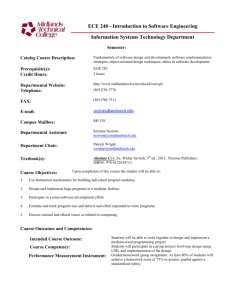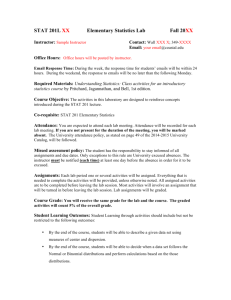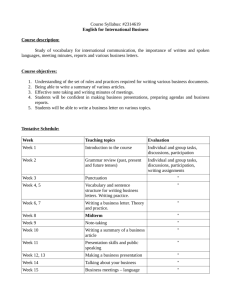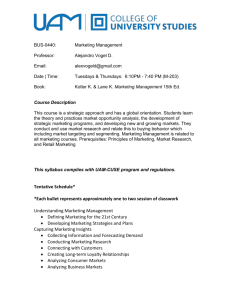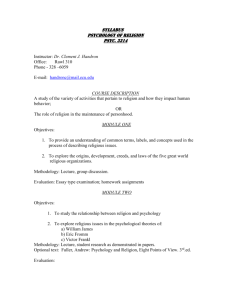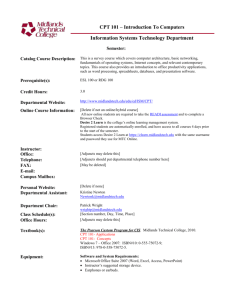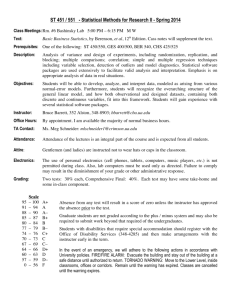CPT 101 Introduction to Computers
advertisement
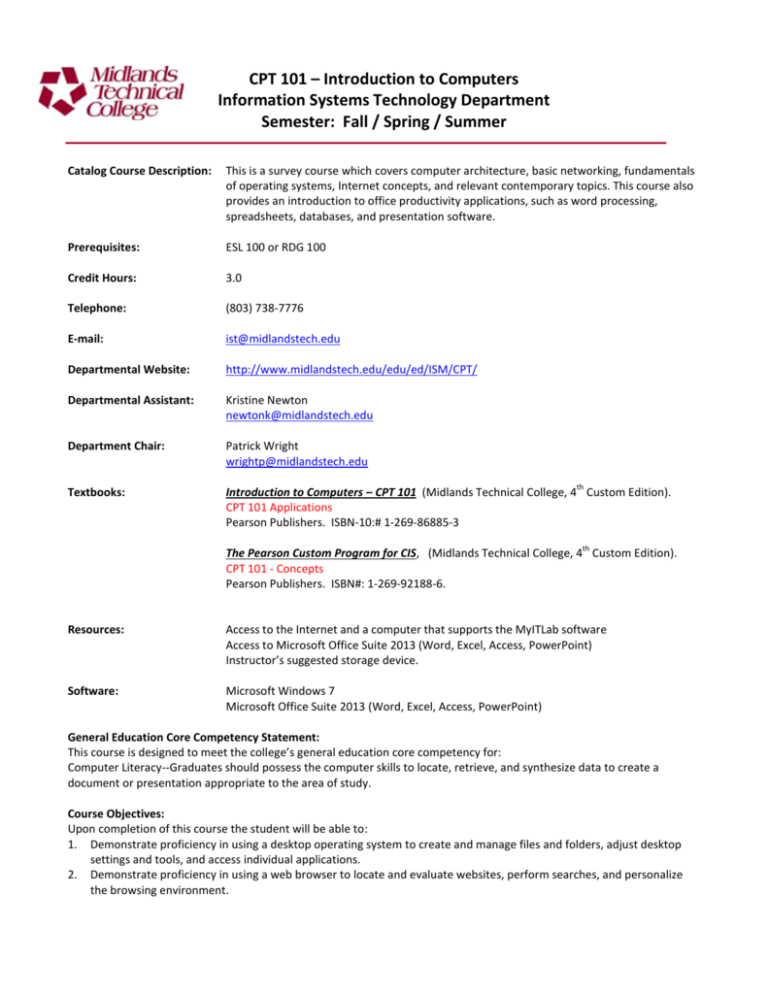
CPT 101 – Introduction to Computers Information Systems Technology Department Semester: Fall / Spring / Summer Catalog Course Description: This is a survey course which covers computer architecture, basic networking, fundamentals of operating systems, Internet concepts, and relevant contemporary topics. This course also provides an introduction to office productivity applications, such as word processing, spreadsheets, databases, and presentation software. Prerequisites: ESL 100 or RDG 100 Credit Hours: 3.0 Telephone: (803) 738-7776 E-mail: ist@midlandstech.edu Departmental Website: http://www.midlandstech.edu/edu/ed/ISM/CPT/ Departmental Assistant: Kristine Newton newtonk@midlandstech.edu Department Chair: Patrick Wright wrightp@midlandstech.edu Textbooks: Introduction to Computers – CPT 101 (Midlands Technical College, 4 Custom Edition). CPT 101 Applications Pearson Publishers. ISBN-10:# 1-269-86885-3 th th The Pearson Custom Program for CIS, (Midlands Technical College, 4 Custom Edition). CPT 101 - Concepts Pearson Publishers. ISBN#: 1-269-92188-6. Resources: Access to the Internet and a computer that supports the MyITLab software Access to Microsoft Office Suite 2013 (Word, Excel, Access, PowerPoint) Instructor’s suggested storage device. Software: Microsoft Windows 7 Microsoft Office Suite 2013 (Word, Excel, Access, PowerPoint) General Education Core Competency Statement: This course is designed to meet the college’s general education core competency for: Computer Literacy--Graduates should possess the computer skills to locate, retrieve, and synthesize data to create a document or presentation appropriate to the area of study. Course Objectives: Upon completion of this course the student will be able to: 1. Demonstrate proficiency in using a desktop operating system to create and manage files and folders, adjust desktop settings and tools, and access individual applications. 2. Demonstrate proficiency in using a web browser to locate and evaluate websites, perform searches, and personalize the browsing environment. 3. 4. 5. 6. 7. 8. 9. 10. 11. 12. 13. Demonstrate proficiency in using a word processing application to create documents and apply page and paragraph formatting; enter, edit, and format text characteristics; insert and format illustrations, tables, and text boxes; use proofing tools to revise a document; and adjust views and program options. Demonstrate proficiency in using a spreadsheet application to create worksheets; format and align text; insert and format illustrations and charts; adjust page attributes; create formulas; use built-in functions; use proofing tools; and adjust views and program options. Demonstrate proficiency in relational database design to manage a database; create, edit, and format database objects, such as tables, queries, forms, and reports; import data, and use database tools to ensure data integrity; and adjust program options. Demonstrate proficiency in using a presentation application to create and edit presentations; insert, format, and manage elements, such as pictures, charts, tables, clip art, audio, and video; apply themes, transitions, and animations; run slide shows; use proofing tools; and adjust views. Demonstrate understanding of how computers function and impact society. Demonstrate understanding of computer hardware and be able to explain the functionality of the parts of a computer system. Demonstrate understanding of the Internet and how to use is effectively and wisely. Demonstrate understanding of system software and what it controls. Demonstrate understanding of application software and be able to describe the various types available. Demonstrate understanding of networking and how it functions. Demonstrate understanding of how to manage and protect digital data and devices. Course Outcomes and Competencies: Intended Course Outcome 1: Students will demonstrate proficiency in the general education core competency of computer literacy: “ Graduates should possess the computer skills to locate, retrieve, and synthesize data to create a document or presentation appropriate to the area of study.” Course Competency: Students will use appropriate Internet websites to research a computer-related topic and organize the information into a cohesive and comprehensive presentation. Performance Measurement Instrument: Students will complete an Internet research project in which they will research a computer-related topic and prepare a PowerPoint presentation according to the instructions provided by the IST department. The PowerPoint project will be scored according to a standardized rubric. Intended Course Outcome 2: Students will demonstrate overall knowledge of operating system, web browser, word processing, electronic spreadsheet, database, presentation software, how computers function and impact society, computer hardware and its functionality, the Internet and how to use it wisely and effectively, system software, application software, basic networking functions, and how to manage and protect digital data and devices. Course Competency: Students will complete simulation exercises covering operating system, web browser, word processing, electronic spreadsheet, database, and presentation software. They will also demonstrate mastery of computer functionality, hardware, system software, application software, networking, and managing and protecting digital devices. Performance Measurement Instrument: Student mastery will be measured with a departmental final examination composed of simulation exercises covering operating system, web browser, word processing, electronic spreadsheet, database, and presentation software. They will also answer objective questions on the exam which cover computer functionality, hardware, system software, application software, networking, and managing and protecting digital devices. Attendance Policy: Students may not miss more than 15% of scheduled classes and attendance assignments, regardless of the reason for the absence. After exceeding this limit, a student will be withdrawn from the class by the instructor. Should the maximum allowable absences be exceeded, a “W” will be submitted to the registrar unless that last absence is after the midterm and the student is failing the course. In that situation, the student will receive a “WF”. Official student holidays and college closings will not count against the student. Semester Type Typical Number of Meetings/Assignments Maximum Allowable Absences Withdrawn After Missing Full Semester 28 4 5 10 Week 20 3 4 Session I/II 14 2 3 In-Class Roll Taking: Attendance will be taken at the beginning of the class period. Students not answering to the roll call or signing the attendance sheet at that time will be marked absent. Students arriving late may check-in with the instructor after class in order to be marked tardy. Three marks of tardy will count as one absence. Students are required to remain in class until class is dismissed, and will otherwise be marked absent, unless prior arrangements are made in advance with the instructor. Attendance records will not be changed retroactively after the scheduled class meeting. Off-Campus Roll Taking – Internet & Hybrid: Off-Campus Attendance is defined as completing a specific attendance assignment by its due date. Within this syllabus, certain assignments are listed as those attached to attendance roll taking. Failure to complete the attendance assignment by its due date is considered an absence. For Internet only classes all of your attendance is taken with this method. For Hybrid courses, attendance is a combination of scheduled classes and those off-campus attendance assignments. Withdrawal: Should the maximum allowable absences be exceeded prior to midterm, a "W" will be submitted to the registrar to be recorded on the student's transcript. Should the maximum allowable absences be exceeded after midterm, a "W" will be submitted to the registrar if the student was passing the course at the time of withdrawal OR a "WF" will be submitted if the student was failing the course at the time of withdrawal. Course Grading: Grading Scale: To be announced by instructor. 90-100 80-89 70-79 60-69 0-59 A B C D F Superior Work Good Word Average Work Below Average Work Unsatisfactory Work Note: Students must earn a grade of “C” or better in all the courses offered within the Information Systems Technology Department for the grade to be counted toward graduation. PLEASE NOTE: Should change become necessary, the instructor reserves the right to adjust the requirements, pace, or scheduling of this course. Any change will be announced in class before it becomes effective. College Policies and Expectations: http://www.midlandstech.com/edu/ed/ism/cpt/syllabi/AcademicAffairsStudentGuidelines.pdf Disabilities Statement and ADA Compliance Issues: The staff of Counseling and Career Services works to ensure that all educational programming and services are accessible to otherwise qualified students with disabilities. If you have a concern regarding the accessibility of websites, instructional materials, online courses and other electronic or information technology, please contact Counseling and Career Services. It is the student's responsibility to selfdisclose as a student with a disability and to request accommodations prior to beginning a program or course. Please contact the staff of Counseling and Career Services at 803-822-3505 (AC) or 803-7387636 (BC) or via email at disability@midlandstech.edu if you have any questions or concerns. Additional Academic Integrity Language: BE WARNED: This instructor vigorously enforces the "Student Code" as documented in The Midlands Technical College "Student Handbook." It should be noted in particular that programming assignments are designed to develop and measure individual programming skill. Therefore, students must prepare programming assignments on their own, and not treat them as group projects. Students must submit only original, individually prepared work for programming assignments. Under no circumstances, and by no means, should students share program designs or solutions with others, in whole or in part, or use designs or solutions obtained from others, either with or without their permission. To do so constitutes academic dishonesty. The instructor will refer all matters relating to academic dishonesty to the Assistant Vice-President of Student Development Services. The instructor reserves the right to make and keep photocopies or electronic copies of student assignments without notice. The proper course of action for students needing help with programming assignments is to contact the instructor immediately.
